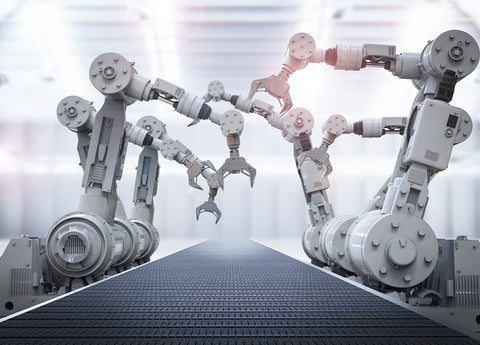
What Are Servo Motors And Servo Drives?
A servo drive is used to power electrical devices connected to the drive and serves as a type of electrical amplifier. In order to select the right type of servo drive, you need to first understand its general functioning and how it interacts with the connected electrical devices.
In addition, you need to make sure the servo motor is paired correctly with the servo drive. For instance, you would not want to pair a brushless DC servo motor with a synchronous servo drive, as they would not be compatible.
Furthermore, manufacturers of servo drives and servo motors like Mitsubishi recommend using OEM (Original Equipment Manufacturer) or OEM-approved drives and motors when you need replacements.
How Does a Servo Drive Work?
A servo drive will constantly and automatically adjust its functions using feedback signals sent to the drive by the connected devices. The drive is also capable of self-adjusting itself when it determines there is a deviation from the desired functions and operations.
All servo drives consist of several basic components, which include:
- Servo Drive
- Servo Motor
- Controller
- Encoder
Each of these parts performs specific functions and operations for the connected device to function correctly like a CNC machine or robotic assembly arm. When the device is turned on, there are several things that occur within the servo drive assembly, as follows:
- The controller sends command signals to the servo drive after calculating what necessary operations must be performed.
- The controller regulates the computer programming and instructions on what the servo motor is to do and when it should perform the desired operations.
- The controller also sends feedback signals to the servo drive to instruct it on how much power to supply the servo motor to perform the desired operation.
- The encoder sends feedback to the servo drive based on functioning so that the drive can alter performance as needed.
- The servo drive alters other operations and functions based on the feedback, including torque, velocity, and positioning.
Is a Servo Controller Necessary for a Servo Drive to Function?
The servo controller is the brains of the operation, so to speak. Without control, the servo drive would not be able to regulate and control what functions it sent to the servo drive. It would not be able to alter the positioning, torque, and velocity as well.
In addition, if there were variances during operation, without a controller, the drive would not receive the necessary feedback so that necessary adjustments to operations can be made to avoid output errors.
Is a Servo Drive and Servo Amplifier the Same Thing?
Yes, a servo drive is also called a servo amplifier and is the same thing. The reason some people call it a servo amplifier is because the drive amplifies the instructions it receives from the controller before sending the function commands to the servo motor.
How Does a Servo Drive System Work?
A servo drive system is all of the components working together. For example, CNC machines and robotic assembly arms require servo drives that can meet high demands. Not only do various parts and components need to accelerate and decelerate quickly but also precisely.
Additionally, precision positioning is necessary. To accomplish this, it is not uncommon to have more than one servo drive system installed. Some manufacturers will combine the drive and controller into a module for devices that require a smaller footprint and make it easier for multiple drive systems to be installed.
Each drive system will perform different functions and operations. For example, in a robotic assembly arm, you could have a servo drive system that rotates the arm left and right. Then, you could have another drive system that adjusts the arm up and down. Next, there could be a third drive system that controls the movement of the “hand” on the arm, as well as how it rotates and moves.
Why Use a Servo Drive System?

A servo drive system makes it possible to perform precision operations and functions in a wide range of industries, from automotive manufacturing to CNC machining. The precision functioning allows for accurate replication for better quality output.
For example, human putting bolts into a car door assembly may not tighten them to the desired torque level each time. With a robotic arm doing the task, it can replicate the process and tighten each bolt to the desire torque level every single time.
Another example is when producing a large quality of precision parts and components using CNC machines. The servo drive system can produce 10, 20, 100, 1,000, or tens of thousands of parts, each exactly identical. Imagine doing that by hand and not having some degree of variance between each one!
What Are Some Benefits of Mitsubishi Servo Drive System?
While all servo drive systems function similarly, there are some great benefits you get with a Mitsubishi servo drive system that is not always offered or available in other drive systems. Some of the main benefits offered include, but may not be limited to:
- Low Heat Generation
- Easy to Maintain
- No Vibrations
- Almost Maintenance-Free
- Easy to Replace When Necessary
- Precision Control
- High Power and Fast Output
- Brushless Drive System
- Options Between Various Drive System Configurations
- Customizations Possible
- Modules Offered to Save Space
- Great Speed Control
- Delivers Constant Torque, Speed, and Movement
- Perfect for Hazardous Environments
- Well-Suited for Dusty Operating Conditions
When Should I Use a Servo Drive System?
You should use a servo drive system in various machines and manufacturing equipment when you desire precise control and precision output. There is a wide range of drive systems to choose from designed for specific industries, industrial applications, and manufacturing processes.
Where Can I Get Mitsubishi Servo Drives, Motors, and Servo Systems?
Whether you require replacement Mitsubishi servo drives, servo motors, or an entire new servo system, you can find what you need at CNC Tools Industrial Electronics. We also carry all the servo parts and components you need from other top manufacturers like:
- Emerson Servo Drives/Systems
- Indramat Servo Drives/Systems
- Siemens Servo Drives/Systems
- Baldor Servo Drives/Systems
- GE Servo Drives/Systems
- Fanuc Servo Drives/Systems
- Hass Servo Drives/Systems
If you need assistance in finding the drive, motor, or servo system you require, just let us know. We have access to a worldwide supply chain network and can locate exactly what you need.
We also offer a wide range of other parts and components for a variety of machines and equipment, including:
- Spindle Drives
- Spindle Drive Motors
- Monitors
- Controls
- Circuit Boards
- Power Supplies
- Rotary Tables
- Other Motors
Experienced Servo Drive System Maintenance, Repairs, and Installations

CNC Tools Industrial Electronics also offers servo drive system maintenance, repair, and installation services to fit your machine and equipment needs. We offer a 6-month, hassle-free warranty on all replacement parts and components. To ensure you always receive the highest quality drive systems, motors, and drives, we go the added step and test all parts and components ahead of time to ensure they function correctly.
To learn more about our Mitsubishi servo drives, motors, and systems, as well as drives, motors, and systems from other top manufacturers, and other parts and components for your equipment and machines, please feel free to contact CNC Tools Industrial Electronics at (956) 246-7411 today!
One of our knowledgeable customer service representatives can prepare a parts and components quote for everything you need for your equipment and machines, as well as help, arrange maintenance, repair, or installation service from one of our experienced technicians.
